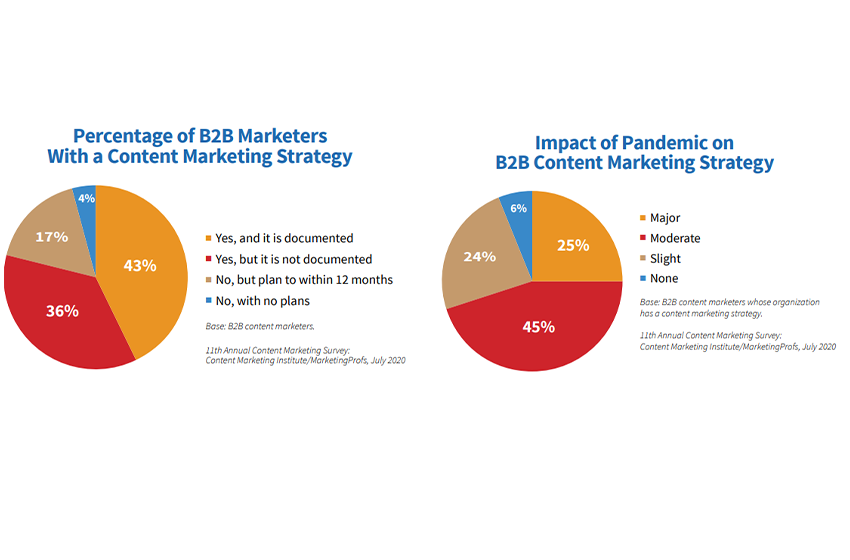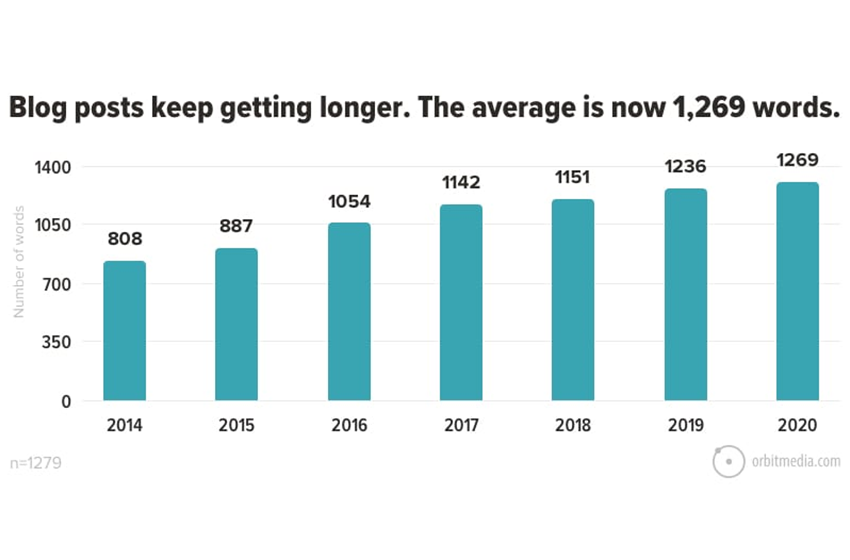
Need to justify that content marketing works? Discover the latest content marketing statistics below. They show that content marketing is one of the most popular marketing strategies for small business. The numbers are stunning.
Over 91% of businesses use content marketing, according to SEMrush. And it’s not hard to understand why. Marketing through content is cost-effective. It’s doable for beginners and small businesses all the way to the largest enterprises. Whether your goal is to attract new customers, get repeat business, or cross-sell to existing customers — it is flexible enough to work in all situations. To prove the benefits, we’ve assembled the best content marketing stats, facts and figures.
Content Marketing Statistics
Content marketing involves using content to formulate marketing strategies and plans. But there are many different types of content including written content, such as blog posts, whitepapers, ebooks, and articles. Content can also mean images and infographics, or video and audio.
Some techniques apply if your business sells to consumers (B2C), or to other businesses (B2B), or to both. With so many small business statistics available, it’s easy to get confused. But these content strategy statistics and metrics will help you make sense of it.

image: Content Marketing Institute
Content Marketing Strategy Stats
Content marketing strategies play a key role in digital marketing plans. In fact, more and more organizations are hiring content marketing services to grow.
A content strategy can be effective in building a brand:
- 31.8% of companies with a content strategy achieve 27.1% higher win rates than those without a content strategy (CSO Insights).
- 80% of people prefer learning about a company through custom content (Demand Metric).
B2C Stats on Content Marketing
When it comes to strategy for B2C content marketers, a report by the Content Marketing Institute (CMI B2C) notes:
- 71% of B2C marketers agree that their company needs a content marketing strategy.
- 33% said they have a documented content marketing strategy.
- Meanwhile, 20% of marketers plan to have a documented content strategy within 12 months.
- Three out of four B2C content marketers believe their company is successful with content marketing efforts.
- Insofar as the preferred content marketing format for B2C marketers, 94% chose social media marketing, and 80% prefer blogs and short articles.
- 39% of B2C content marketers say their companies are in a sophisticated or mature phase of content marketing maturity.
The top strategic goals that B2C marketers have achieved through content marketing in the last 12 months are:
- create brand awareness (84%),
- educate their audience (75%),
- build credibility and trust (65%), and
- generate demand and leads (61%).
But interestingly, only 48% have used content to directly generate sales and revenue. (CMI B2C).
B2B Statistics on Content Marketing
If you are a B2B marketer, the content marketing B2B statistics are a bit different. According to the B2B Content Marketing: Benchmarks, Budgets and Trends report by the Content Marketing Institute (CMI B2B):
- 43% of B2B marketers have a “documented” content marketing strategy.
- 36% of B2B marketers have a content marketing strategy, but have not documented it.
- Another 17% plan to have a content marketing strategy in the next 12 months.
As far as strategic goals, additional B2B marketing stats from the Content Marketing Institute are:
- 86% of B2B content marketers rated creating awareness of their brand as their biggest goal over the past 12 months.
- 79% said their biggest goal is educating the audience. Building credibility and trust, generating demand and leads and nurturing subscribers, audience and leads also ranked high as goals among B2B marketers.
Content Marketing ROI Statistics
Return on investment (ROI) is a critical part of any digital marketing campaign. But the first question is, how many marketers actually measure content marketing ROI? The answers may surprise you:
- For B2C content marketers, only 51% measure ROI on content marketing, according to the Content Marketing Institute (CMI B2C). The most common metric measured is conversions, at 81%. Other top metrics are website traffic (80%), website engagement (79%), and social media analytics (76%).
- For B2B marketers, the good news is that 81% are using metrics to track their performance. However, 90% are merely tracking site traffic. Email opens, clicks, and other email stats are the next most common tracked metric at 86%. Only 37% track the cost to acquire a lead or customer (CMI B2B).
But ROI for content marketing is proven and pays off, as per the following statistics:
- The cost of acquiring a new customer through content is around 15% less than through paid channels for subscription-based businesses (Profit Well).
- Subscription-based businesses using content see 5-10% better retention rates (Profit Well).
- 96% of marketers find content marketing to be effective for their companies (Zazzle).
Content Marketing Budgets
When it comes to content marketing budgets, for B2C marketers the annual budget averages $230,000. Of course, respondents in the study included some very large enterprises. For small businesses with under 100 employees the average budget for content marketing is less than half, at $111,000 annually (CMI B2C).
For B2B company content marketing budgets (per CMI B2B):
- 47% had an annual content marketing budget of less than $100,000.
- 7% had budgets exceeding $500,000.
- For small businesses of under 100 employees, about 57% of those had budgets under $100,000.
- Even more interesting: 32% of small businesses did not have any established budget for content marketing.
The 2020 pandemic increased the emphasis on doing business online, and by extension using content marketing to attract customers. That affected budgets. One third of respondents anticipated increasing B2B content marketing and content creation spending as a result, according to the Content Marketing Institute report.
SEO and Content Stats
Good search engine optimization (SEO) increases organic traffic, which in turn cuts down on paid advertising. And good SEO depends heavily on content – you must “feed the search engines” if you want your content (and site and products) to get found by searchers.
To rank well, content creation requires adept usage of keywords and other search engine optimization techniques.
SEO boosts visibility of your content. The result is that more people find your website or products in Google, and click through, according to Ignite Visibility’s Google Click-Through Rates by Ranking Position 2020 report (Ignite Visibility):
- According to the report, 55% of people say they would click on a familiar brand in search results.
- And 85% said they prefer to click on organic results.
Buyers use search engine content to research purchases. Having a powerful SEO strategy can increase the number of prospects and your conversion rate. According to FRACTL’s The Truth about Inbound and Outbound Marketing report (FRACTL):
- 89.5% of people use online search to gather information about a product or company.
- 81.3% visit a brand’s website to learn more about a company or product.
Creating sufficient SEO-optimized content can be a challenge. SEO content must include well-researched keywords. A 2020 report from SEMrush explains:
- Creating content that generates quality leads is the biggest challenge for 54% of marketers.
- 60% of marketers do not outsource content creation at all, but apparently do it all themselves.
- The report also reveals that 94% of marketers use social media content to raise awareness.
The value of search engines and Google search is well recognized:
- Optimizing content for Google Search is a must. Google dominates search engine use with an average net market share of 70.38% (Smart Insights).
- Getting featured in the top Google results can grow business. For example, 60% of smartphone users have reached out to a business directly using the search results (Think with Google).
- See PPC statistics for more.
Email Marketing and Blog Stats

image: Orbit Media
Blog content creation is essential in the marketer’s arsenal. One of the most popular types of content is the blog post.
About 86% of B2B marketers use their organization’s blog to distribute marketing, according to the Content Marketing Institute’s B2B Content Marketing: Benchmarks, Budgets and Trends 2020 report. Here are specific business blogging stats:
- Informative, well optimized blog posts can increase organic traffic to websites. Companies that blog receive 55% more internet users to their websites than those that don’t blog (HubSpot). Respondents rate the content quality of the blog post as the most important success factor.
- Working with an editor has a direct impact on the success of your blog posts. One in three bloggers work with an editor and bloggers who update old blog posts are 3x more likely to get success (Orbit Media).
- Length of the blog post has a direct impact on social shares. Blogs of long-form content (3000 to 10,000 words) get more social shares than short-form content. Listicles, infographics, how-to articles, what / why posts, and videos are the most commonly shared content formats. And listicle articles with 10 items get more shares than others (OkDork).
- All copywriting statistics enforce the importance of a good headline. On average 8 out of 10 readers will read headline copy, but only 2 out of10 will read the rest (Copyblogger).
Blogs and articles can be very useful resources for establishing thought leadership. According to an Edelman research survey:
- Around 88% of decision-makers think thought leadership is an effective tool to enhance an organization’s perceptions.
- However, only 17% of respondents rate the quality of thought leadership they read as very good or excellent.
Content marketing and email marketing can work together to build your business. Here are useful email marketing statistics:
- 87% of B2B marketers use emails in their content marketing (CMI B2B).
- Make sure your emails are readable and formatted for mobile. Mobile opens accounted for 46% of all email opens (Litmus).
- Email marketing can help businesses retain customers. 80% of organizations believe that email marketing is effective to increase customer retention (Emarsys).
- 53 to 73% of millennials prefer communications from businesses via emails (HubSpot).
Lead Generation and Content Marketing
Creating quality content for B2B audiences can help in lead generation. Smart content marketers create “lead magnet” content in order to entice B2B buyers to share their contact information. Examples of lead generating content include case studies, interactive content that draws B2B buyers in, resources such as white papers, and even blogs. In this way, B2B marketers gather leads.
- Almost half of B2B marketing experts use white paper marketing, with 47% saying they used white papers in the last 12 months (CMI B2B).
- 57% of B2B buyers said they are willing to share information in exchange for case studies, 63% would do so for e-books, 66% would share information in exchange for third-party or analyst reports, 76% would do so for white papers and 79% would share information in exchange for a webinar. That’s according to Demand Gen’s Content Preferences Survey Report (Demand Gen Report).
- Meanwhile, 19% of buyers will exchange information for podcasts and videos, and 24% of buyers will do the same for infographics (Demand Gen Report).
- Content marketing generates three times as many leads as traditional marketing for every dollar spent.
- And running content marketing campaigns costs 62% less than traditional marketing. Demand Metric: The Guide to Marketing Genius: Content Marketing (Demand Metric).
Podcast and Video Content Marketing Statistics
The latest video marketing statistics and podcast trends show that businesses are increasingly exploring different types of content formats to reach the target audience. Adept marketers build a library of video and audio resources.
According to Wyzowl’s Video Marketing Statistics 2020 report (Wyzowl), here are some video content marketing stats:
- 87% of those surveyed said video marketing has increased traffic to their websites, and 81% of respondents said video marketing increases the time visitors spend on the page.
- An explainer video can help the audience to learn about products. 96% of people have said that they have watched an explainer video to understand a product or service.
- 87% of respondents say that video marketing has increased traffic to their websites, and 81% of respondents say videos increase the time visitors spend on the page.
How effective is video from a marketers point of view? Animoto research says:
- About 88% of video marketers are satisfied with the ROI of video marketing efforts on social media.
- Also, 93% of video marketers say that posting a video on social channels leads to acquiring a customer.
In the Discover Pods Podcast Trends report, marketers can see how podcasts can reach their customers (Discover Pods):
- For example, 82.4% of users listen to podcasts for more than 7 hours each week.
- As a result, 59% of users spend more time listening to podcasts than they do on social media.
Adopting podcasts can be a good digital marketing strategy because podcasts can help businesses sell products. Want more proof?
- Consider that 61.3% of respondents said they bought an item after listening to an ad on a podcast.
- However, 61.3% of podcasters state that marketing and building an audience are among their top challenges.
What’s more, according to The Infinite Dial report on podcasting from Edison Research, the appetite for this particular content marketing platform is growing:
- Consider that 75% of Americans age 12+ are now aware of podcasting, which is 5% up from 2019.
- And 55% of Americans have listened to a podcast at least once.
Visual Content Marketing Statistics
One of the biggest differences between content marketing today and five years ago is that more emphasis is now placed on visuals. Searchers and buyers want to see things in more than text. The following visual content marketing statistics from Venngage show how important visuals are to digital marketing strategies.
- 49% of respondents said visuals are very important to their marketing strategy.
- 74% of marketers said more than 70% of their content includes some form of visual.
- 62% of respondents said they create visuals for blogs or landing pages.
- Stock photography is on the rise and more readily available today at low cost. So it is no surprise that the most commonly used visuals are stock images (40%).
- Other frequently used visuals are original graphics (34%), videos and presentations (14%), and charts and data visualizations (8%).
- 72% of marketers spend less than 10 hours each week producing visual content.
- 36% of marketers use an online tool or graphic maker to create this type of content. See these infographic tools to create your own beautiful infographics, some with interactive content.
Visual content has perhaps the biggest impact in social media marketing. Marketers say they need every edge, because social media algorithm changes make it harder than ever to get visibility:
- Facebook posts with images get 2.3x more engagement than those posts without images (BuzzSumo).
- Tweets with images receive 150% more engagement than those tweets without images (Buffer).
- 130 million Instagrammers check shopping posts every month (Instagram).
- 200 million Instagrammers check at least one business profile daily (Instagram).
- 6 in 10 Instagram users visit the platform at least once a day (Pew Research).
- Influencers on Instagram get between $100 and $2,085 per post from brands (eMarketer).
- See more Instagram statistics.
Top 3 Content Marketing FAQs
The following are among the most often asked questions here at Small Business Trends by marketers and small business owners.
How much staff do small businesses dedicate to content marketing?
Almost three-fourths of smaller businesses have zero or just one person dedicated to content marketing full-time (CMI B2B). The breakdown is as follows for small businesses with under 100 employees:
- 44% have no full-time person assigned to marketing with content.
- 29% have one full-time person.
- 27% have two or more full-time people .
How much should I budget for content marketing?
B2B companies spend 26% of their total marketing budget on content marketing. B2C companies spend 22% of their total marketing budget on content marketing. However, most successful companies spend closer to 40% of their total marketing budget on content marketing. (Marketing Insider Group)
What is the most popular type of content marketing?
The most popular type of content marketing is blog content, followed by email and infographic content marketing. About 86% of businesses engage in blogging, while 67% of businesses send emails. Another 45% of businesses do infographic content marketing. (SEMrush).
Image: Depositphotos.com
This article, “Content Marketing Statistics You Should Know” was first published on Small Business Trends